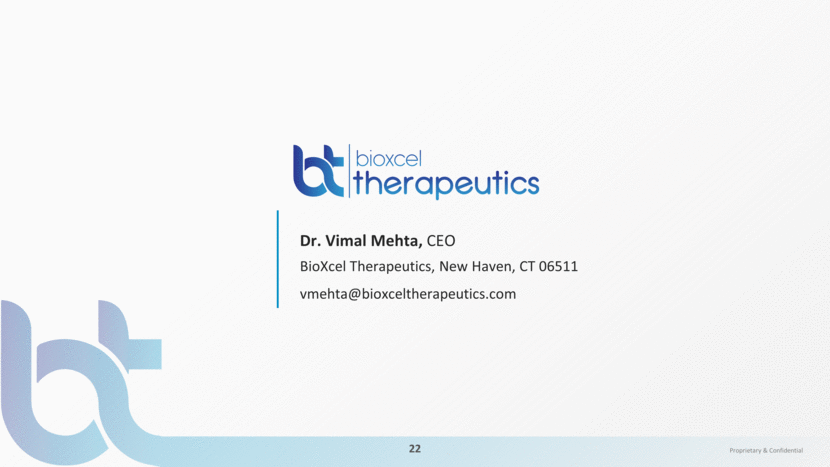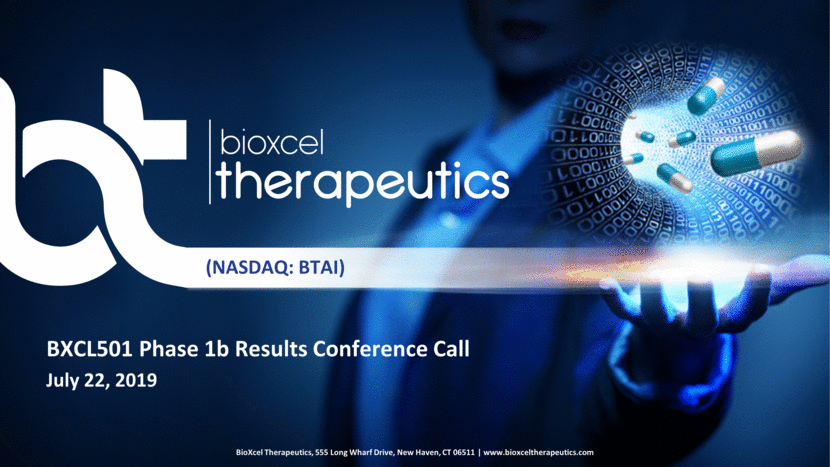Forward-Looking Statements This presentation includes “forward-looking statements” within the meaning of the Private Securities Litigation Reform Act of 1995. Forward-looking statements in this presentation include, but are not limited to, statements that relate to the advancement and development of BXCL501 and BXCL701, the commencement of clinical trials, the availability and results of data from clinical trials, BioXcel Therapeutic, Inc.'s (“BTI”) submission of its first New Drug Application with the FDA and other information that is not historical information. When used herein, words including “anticipate”, “being”, “will”, “plan”, “may”, “continue”, and similar expressions are intended to identify forward-looking statements. In addition, any statements or information that refer to expectations, beliefs, plans, projections, objectives, performance or other characterizations of future events or circumstances, including any underlying assumptions, are forward-looking. All forward-looking statements are based upon BTI's current expectations and various assumptions. BTI believes there is a reasonable basis for its expectations and beliefs, but they are inherently uncertain. BTI may not realize its expectations, and its beliefs may not prove correct. Actual results could differ materially from those described or implied by such forward-looking statements as a result of various important factors, including, without limitation, its limited operating history; its incurrence of significant losses; its need for substantial additional funding and ability to raise capital when needed; its limited experience in drug discovery and drug development; its dependence on the success and commercialization of BXCL501 and BXCL701 and other product candidates; it ability to receive regulatory approval for its product candidates; its ability to enroll patients in its clinical trials; its approach to the discovery and development of product candidates based on EvolverAI is novel and unproven; its exposure to patent infringement lawsuits; its ability to comply with the extensive regulations applicable to it; its ability to commercialize its product candidates; and the other important factors discussed under the caption “Risk Factors” in its Quarterly Report on Form 10-Q for the period ended March 31, 2019 as such factors may be updated from time to time in its other filings with the SEC, which are accessible on the SEC's website at www.sec.gov. These and other important factors could cause actual results to differ materially from those indicated by the forward-looking statements made in this presentation. Any such forward-looking statements represent management's estimates as of the date of this presentation. While BTI may elect to update such forward-looking statements at some point in the future, except as required by law, it disclaims any obligation to do so, even if subsequent events cause our views to change. These forward-looking statements should not be relied upon as representing BTI's views as of any date subsequent to the date of this presentation.
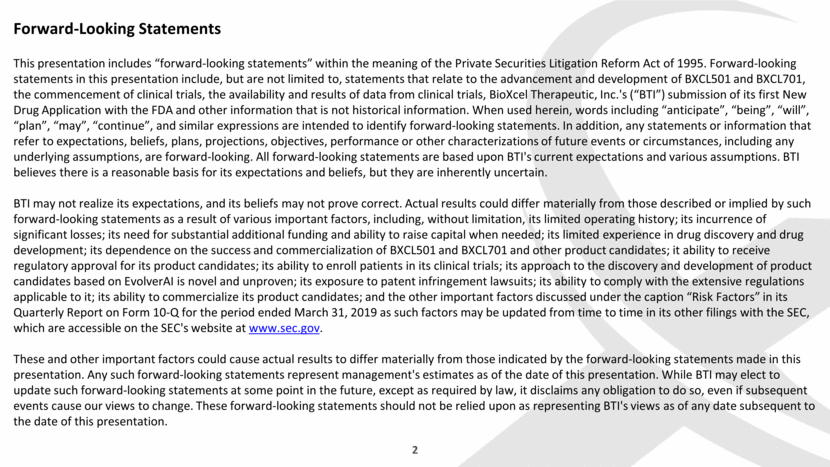
Agenda BXCL501 Phase 1b Trial Results Overview and Summary Vimal Mehta, Ph.D., CEO & Founder BXCL501 Phase 1b Trial Design and Results Rob Risinger, M.D., VP, Clinical Development Q&A BioXcel Therapeutics Team Corporate Outlook & Closing Remarks Vimal Mehta, Ph.D., CEO & Founder BioXcel Therapeutics Team Chetan Lathia, Ph.D., SVP and Head, Translational Medicine, Clinical Pharmacology and Regulatory Affairs Richard Steinhart, Chief Financial Officer Vincent O'Neill, M.D., Chief Medical Officer Frank Yocca, Ph.D., Chief Scientific Officer
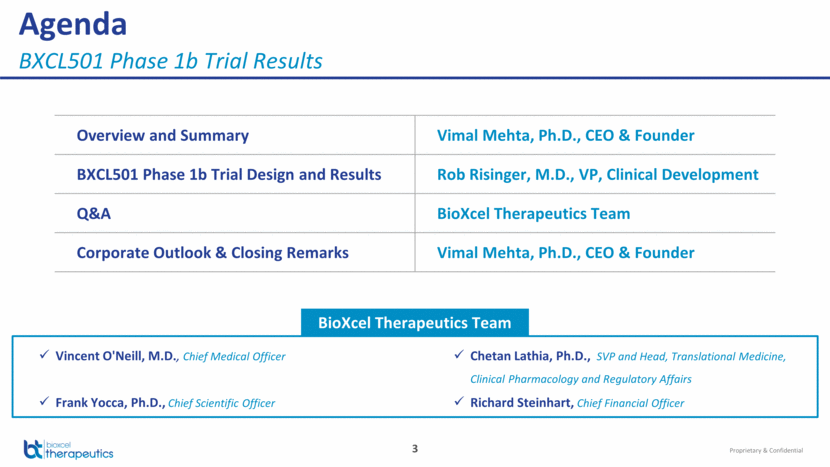
Overview and Summary Vimal Mehta, Ph.D., CEO & Founder
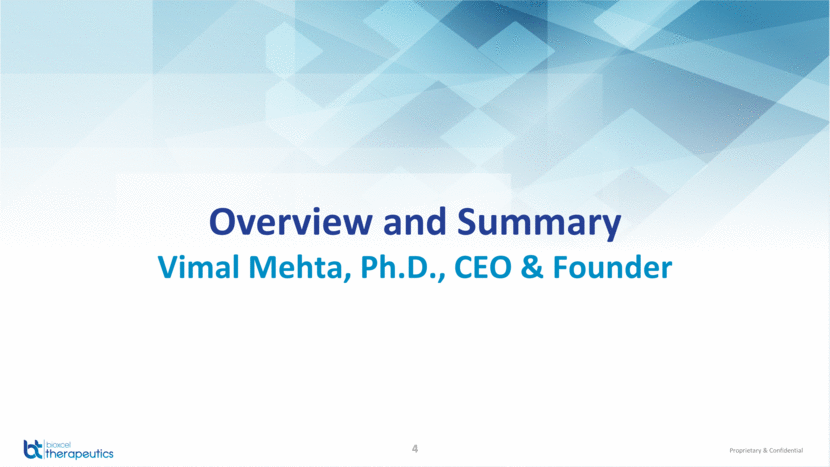
BXCL501 Phase 1b Trial Summary of Results BXCL501: a potential first-in-class, proprietary sublingual thin film of dexmedetomidine, a selective alpha-2a receptor agonist (a novel mechanism of action). Clinically meaningful, rapid and durable reductions in PEC score in acute treatment of agitation in schizophrenia patients. Statistically significant mean reduction in PEC score at two hours compared to placebo following a single dose of 180 mcg (p<0.0001), with rapid and durable effects maintained for 4 to 6 hours across multiple dose strengths. Approximately 90% of patients met response criteria at 180 mcg with a reduction in PEC score (>40%). Well-tolerated with no serious or severe adverse events across the entire dose range. Data support progressing BXCL501 program potentially to Phase 3 pivotal trials, subject to discussions with FDA.
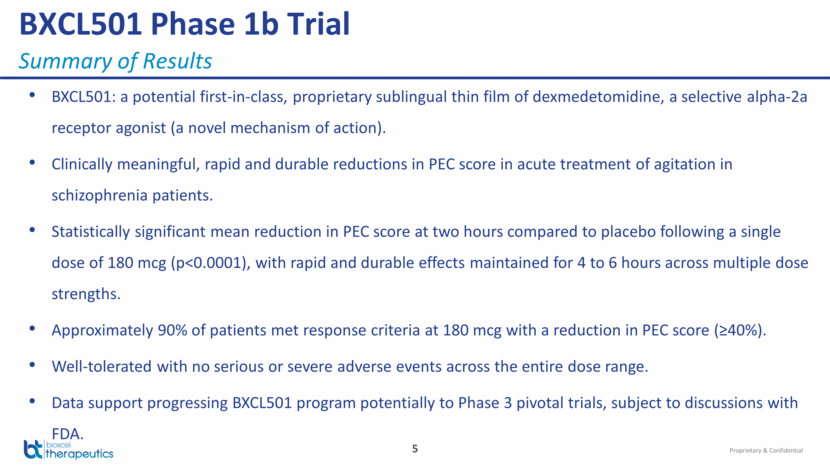
About Agitation Overview Common and costly phenomenon associated with number of psychiatric conditions - 8.3 million suffer from agitation each year in the US - $40 billion per year health care burden Consensus guidelines recommend non-coercive management strategies to protect therapeutic alliance between patients and healthcare providers Unmet medical need: rapid symptom relief with non-invasive approach 8.3M 3M - 5M Add Text ~19M At Risk Suffer Agitation Mild to Moderate Agitation
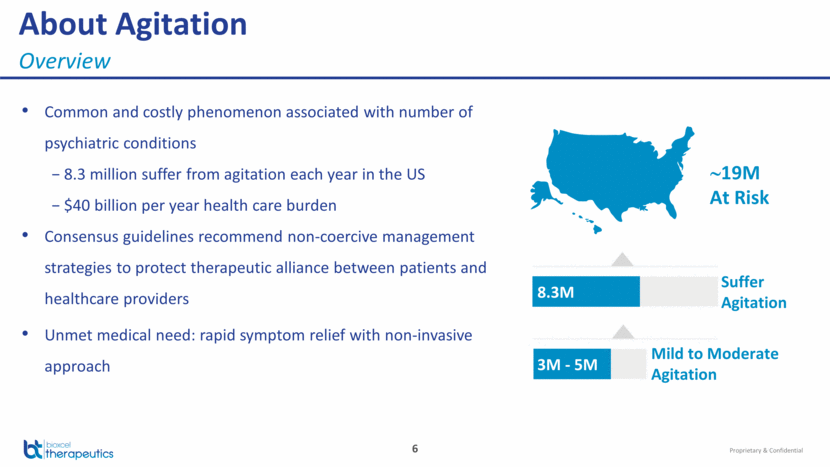
BXCL501: Large Market Potential Anticipated Timeline: First NDA submission in 2H 2020 1H 2020 INDICATION 1H 2019 2H 2019 2H 2020 2021 2022 Trial Initiation Clinical Plan Under Development Clinical Plan Under Development Commercial Launch Phase 3: Schizophrenia & Bipolar Disorder Schizophrenia/ Bipolar Disorder (Acute Agitation) Dementia (Acute Agitation) Opioid Withdrawal (Symptoms) NDA Submission Phase 1b: Schizophrenia Delirium (Acute Agitation) Roll-out of Clinical Plan
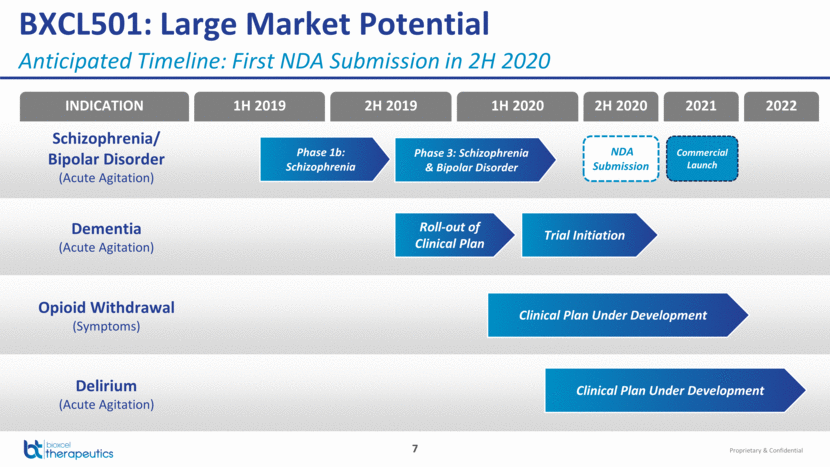
BXCL501 Phase 1b Trial Design and Results Rob Risinger, M.D., VP, Clinical Development

Current Treatments are Suboptimal: Dementia: Antipsychotic drugs (black-box warning) for elderly Psychiatric: Invasive with severe side effects BXCL501 Sublingual Thin Film Dexmedetomidine (Dex) for Acute Treatment of Agitation Fast Track Designation Non-invasive Calmness without sedation Easy to administer Rapid onset Non-traumatic / non-coercive Good safety profile Favorable tolerability Patient preference Consensus Opinion* *1st International Experts’ Meeting on Agitation: Conclusions Regarding the Current and Ideal Management Paradigm of Agitation, Frontiers in Psychiatry 2018 Unmet Need BXCL501: Novel Mechanism of Action (MoA) Non-Invasive, easy to administer sublingual thin film designed for rapid onset of action
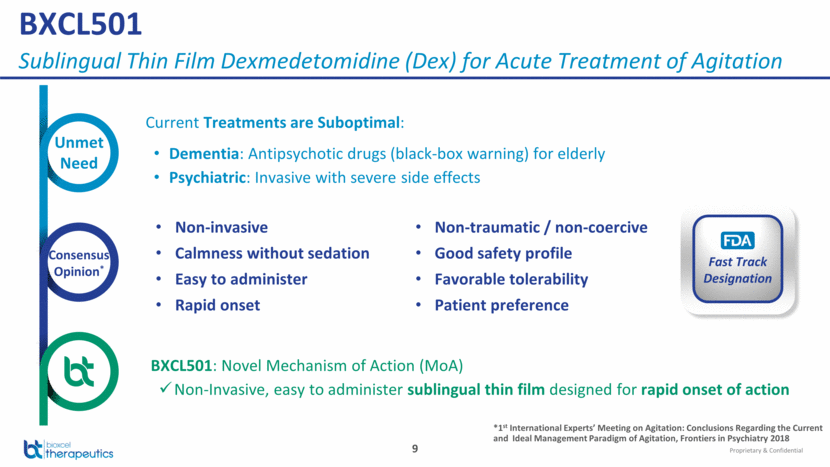
BXCL501 Phase 1b Trial Clinical Trial Design Phase 1b, randomized, double-blind, placebo-controlled, multi-center, U.S. trial N=135 adult patients with confirmed diagnosis of schizophrenia 6 hour treatment period - Single dose* Dose groups (2:1 randomization) - BXCL501 (20, 60, 80, 120, and 180 mcg) - Placebo *The lowest dose tested, 20 mcg was repeated in subjects who did not achieve response criterion.
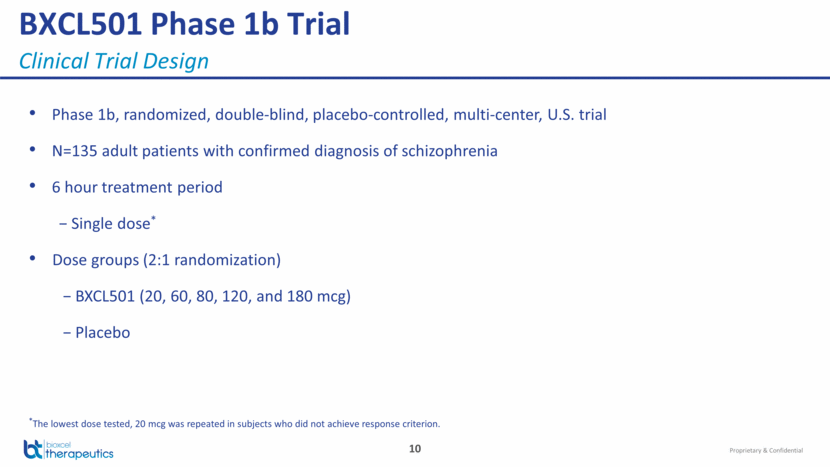
BXCL501 Phase 1b Trial Clinical Trial Design BXCL501 (20, 60, 80, 120, 180 mcg) Assessing Agitation Episodes in Schizophrenia Placebo Agitated Schizophrenia Patients Screening Period Primary Endpoint: Change from baseline in PEC score (PANSS-Excitatory Component) Initiated May 2019 Completed July 2019 N = 135 2:1 Randomization Evaluation Period (6 hours) N = 90 N = 45 0 min 60 min 120 min 180 min 240 min 300 min 360 min * * Patients Dosed
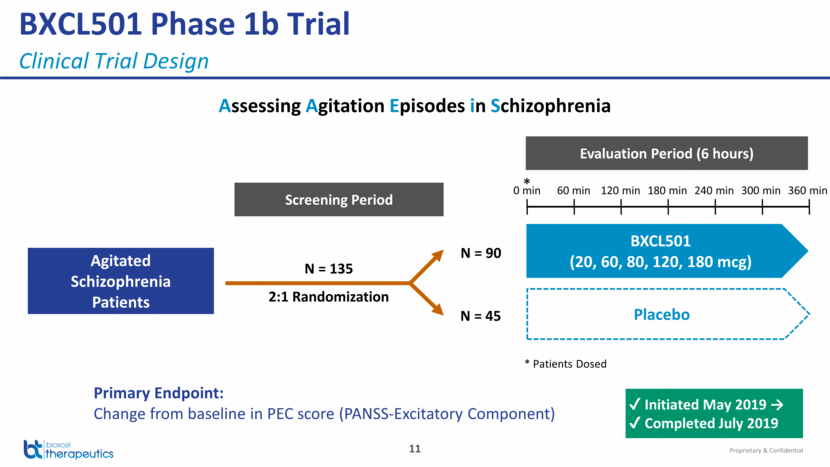
BXCL501 Phase 1b Trial Demographics and Baseline Characteristics Mean age (years): 48.4 for placebo group, 47.2 for BXCL501 group - 89 males:46 females Mean PEC score at baseline: 18.1 (range 14 – 25) for placebo group, 17.8 (range 14 – 26) for BXCL501 group Subjects were on a range of typically prescribed antipsychotics.
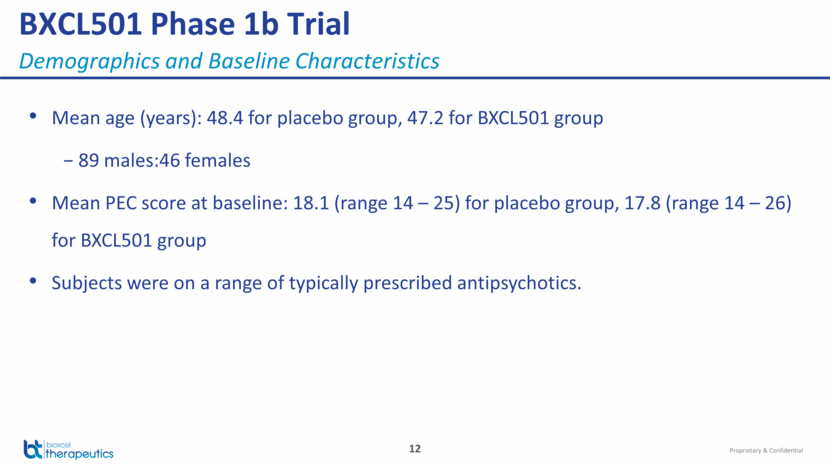
BXCL501 Phase 1b Primary Endpoint: Change in PEC Score from Baseline % Responders (Reduction in PEC of > 40%) Mean Change in PEC Score from Baseline P-Value Placebo N=36 28% -4.5 BXCL501 (180 mcg) N=18 89% -10.8 < 0.0001 BXCL501 (120 mcg) N=18 67% -9.2 0.0003 BXCL501 (80 mcg) N=18 56% -7.1 0.0152 BXCL501 (60 mcg) N=18 39% -6.0 0.1227 *The lowest dose tested, 20 mcg (not shown) was repeated in subjects who did not achieve response criterion At Time = 120 Min (Primary Endpoint) Change in PEC Score from Baseline (Least Squares means) 0 60 120 180 240 300 360 -12 -10 -8 -6 -4 -2 0 Time Post Dose (Minutes) ** *** *** *** *** * Placebo 180 mcg 80 mcg * * * * ** * * = p < 0.05 ** = p < 0.001 *** = p < 0.0001
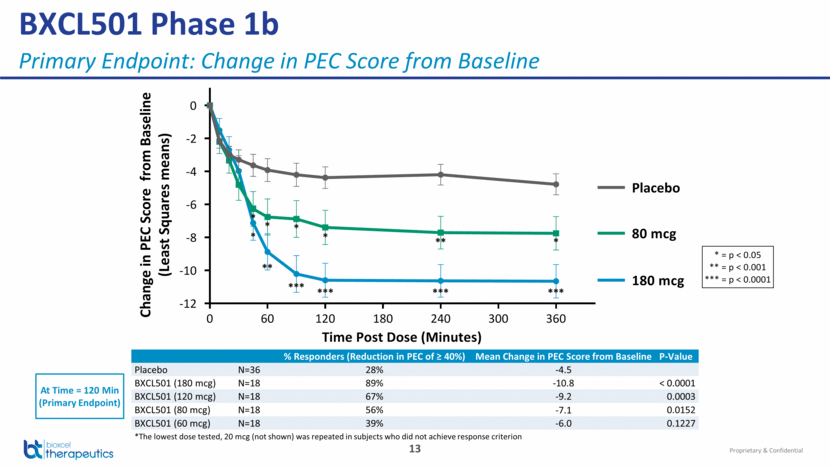
BXCL501 Phase 1b Secondary Evaluation: Change in ACES from Baseline Mean Change in ACES Score From Baseline P-Value Placebo N=36 1.20 BXCL501 (180 mcg) N=18 3.94 < 0.0001 BXCL501 (120 mcg) N=18 3.11 0.0005 BXCL501 (80 mcg) N=18 2.33 0.0156 BXCL501 (60 mcg) N=18 2.11 0.0750 *The lowest dose tested, 20 mcg (not shown) was repeated in subjects who did not achieve response criterion Placebo 80 mcg 180 mcg 0 1 2 3 4 5 Dose C h a n g e i n A C E S S c o r e f r o m B a s e l i n e ( L e a s t S q u a r e s M e a n ) p = 0.0156 p = <0.0001
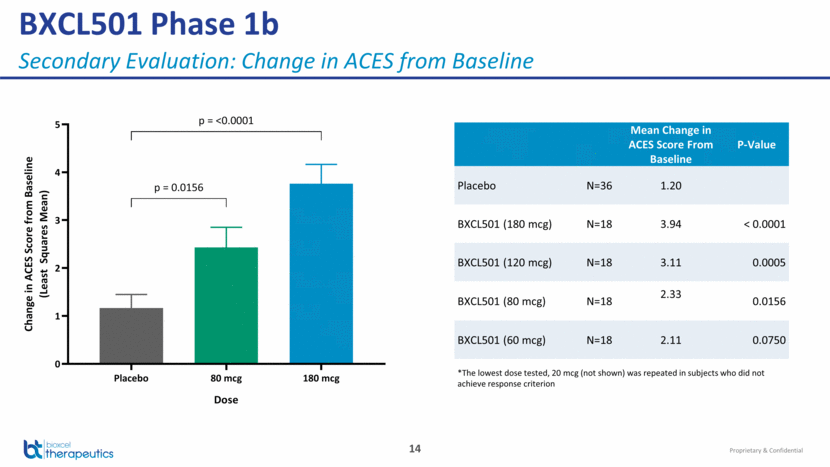
BXCL501 Phase 1b Trial Safety BXCL501 was well-tolerated with no serious or severe adverse events across the entire dose range. The most common treatment-related adverse events were mild somnolence and dry mouth. A maximum tolerated dose was not reached. All subjects (100%) were able to self-administer the film and complete the study.
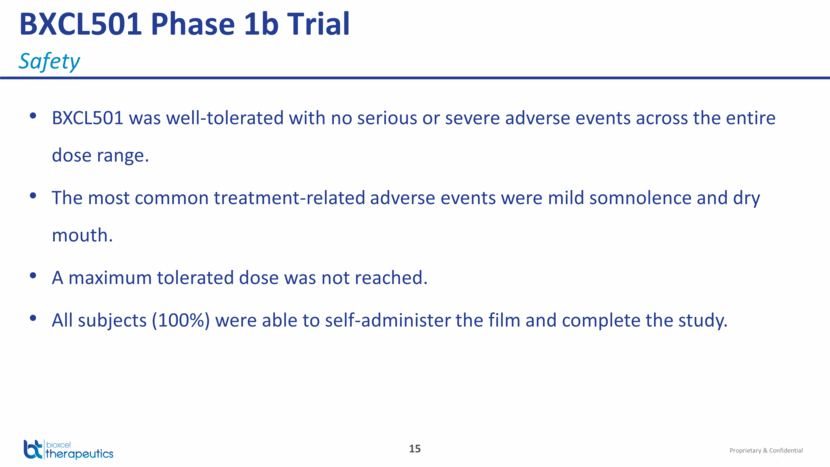
BXCL501 Phase 1b Trial Summary Statistically significant improvement in PEC score in the 80, 120, and 180 mcg dose groups for BXCL501 in patients with schizophrenia. Calming effect was durable lasting at least 6 hours as evidenced by separation from placebo for 80, 120 and 180 mcg dose groups. Well-tolerated across all doses tested. A maximum tolerated dose was not observed. We believe data support progressing the BXCL501 program to pivotal trials, subject to further discussions with the FDA.
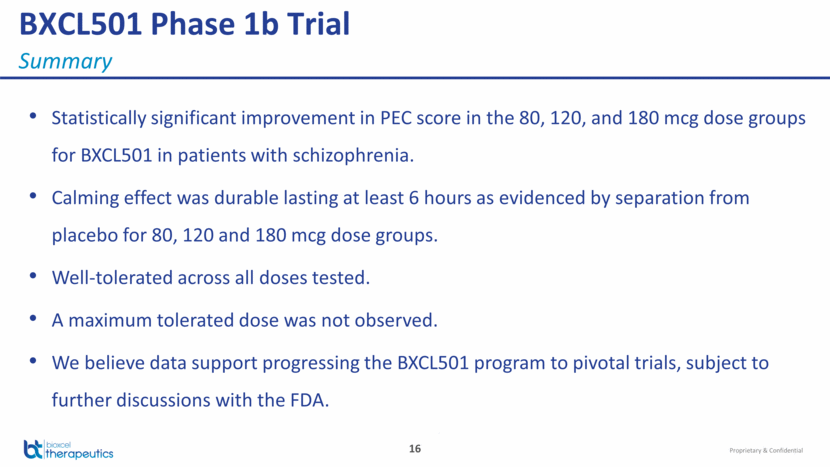
BXCL501 Phase 3 Pivotal Trial Expected Clinical Trial Design BXCL501 (Two doses) Assessing Agitation Episodes in Schizophrenia and Bipolar Disorder Placebo Trial 1: Agitated Schizophrenia Patients Screening Period Primary Endpoint: Change from baseline in PEC score (PANSS-Excitatory Component) Expected to Initiate 4Q 2019 N = 600 to 700 1:1 Randomization Evaluation Period (6 hours) 0 min 60 min 120 min 180 min 240 min 300 min 360 min * * Patients Dosed Trial 2: Agitated Bipolar Patients
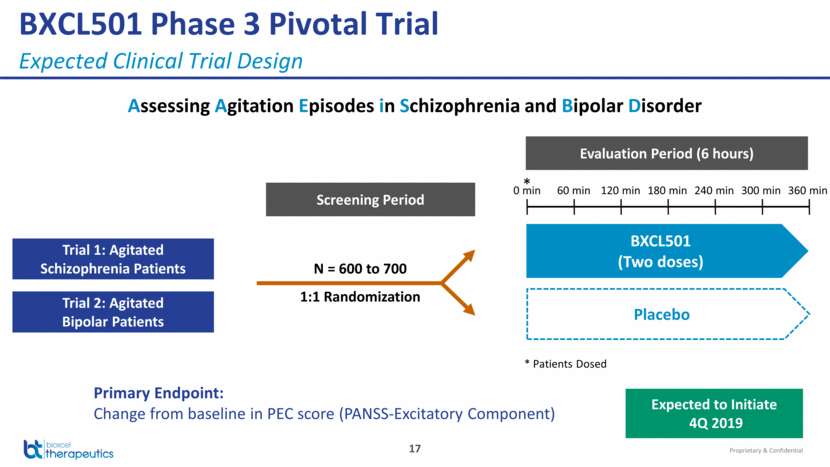
Key Targeted Milestones for Value Creation On Track For First NDA Submission In 2H 2020 BXCL501 Anticipated Timeline Schizophrenia / Bipolar Disorder Phase 1b Trial Initiated (May 2019) Phase 3 Pivotal Trial Initiation First NDA Submission Phase 1b Data Readout (July 22, 2019) Phase 3 Data Readout Development Plans for Agitated Dementia, Opioid Withdrawal Symptoms And Hyperactive Delirium will be Presented Through 2019 2Q’19 3Q’19 4Q’19 1H’20 2H’20
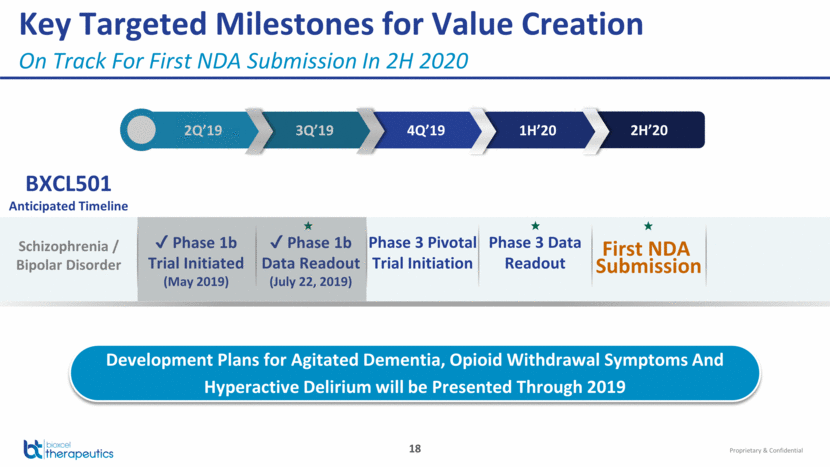
BXCL501: Large Market Potential Anticipated Timeline: First NDA Submission in 2H 2020 1H 2020 INDICATION 1H 2019 2H 2019 2H 2020 2021 2022 Trial Initiation Clinical Plan Under Development Clinical Plan Under Development Commercial Launch Phase 3: Schizophrenia & Bipolar Disorder Schizophrenia/ Bipolar Disorder (Acute Agitation) Dementia (Acute Agitation) Opioid Withdrawal (Symptoms) NDA Submission Phase 1b: Schizophrenia Delirium (Acute Agitation) Roll-out of Clinical Plan
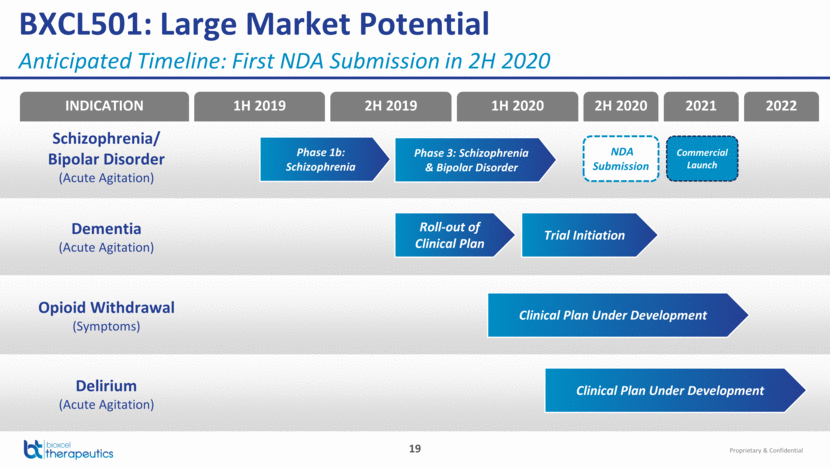
Q&A
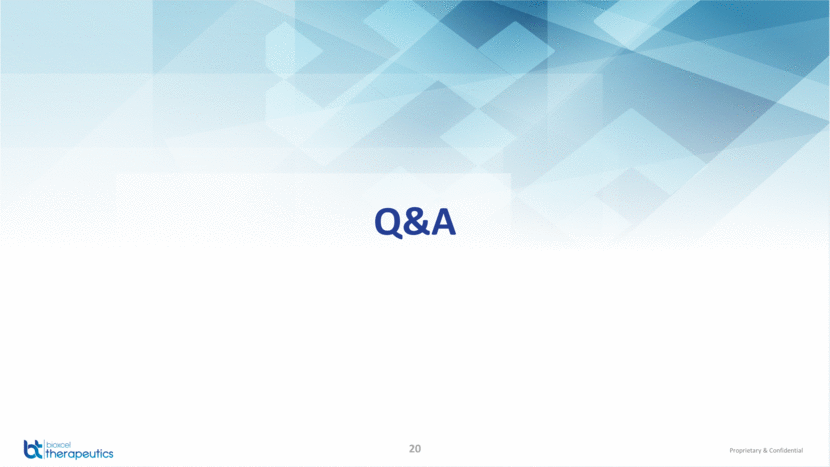
Corporate Outlook And Closing Remarks Dr. Vimal Mehta, CEO & Founder
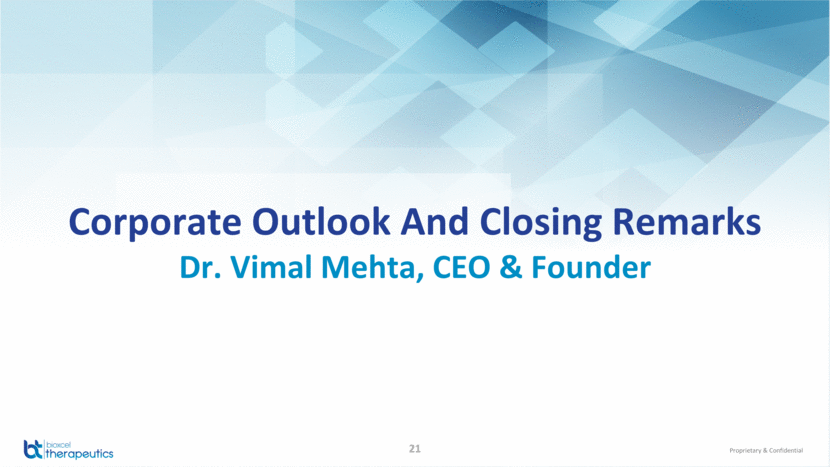
Dr. Vimal Mehta, CEO BioXcel Therapeutics, New Haven, CT 06511 vmehta@bioxceltherapeutics.com
